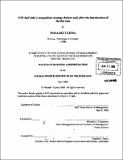NTT DoCoMo's competition strategy (before and) after the introduction of the flat rate
Author(s)
Yajima, Masaaki
DownloadFull printable version (26.29Mb)
Alternative title
Nippon Telegraph and Telephone Do Communications Over the Mobile Network's competition strategy (before and) after the introduction of the flat rate
Other Contributors
Sloan School of Management.
Advisor
Michael A. Cusumano.
Terms of use
Metadata
Show full item recordAbstract
NTT DoCoMo, which was spun off from NTT in 1992, grew rapidly by increasing the number of subscribers and successfully implementing a new data communication, i-mode. However, when a competitor introduced a flat rate for data communication, the situation changed dramatically for NTT DoCoMo, as its operating profits and enterprise value began to decrease. Today the company is struggling to develop a new growth driver that will be effective in this new age of flat rates. In this thesis, I analyze the early successes of NTT DoCoMo, including both its voice and communication services, as well as i-mode. My analysis utilizes several frameworks: (1) Michael Cusumano's eight-point analysis for start-ups; (2) Michael Porter's five forces analysis and four factors analysis; and (3) an analysis from the perspective of four important competitive factors in the mobile phone industry. Next I consider the impacts of the introduction of flat rate on data communication. I analyze the industry's background at the time of the flat-rate introduction, and present some quantitative analysis. Finally, I analyze NTT DoCoMo's strategy for dealing with the flat rate. NTT DoCoMo is trying to establish new business models within, as well as outside, the mobile telecommunications industry, and I evaluate these new business models. In particular, the credit card business appears to hold considerable promise for the mobile telecom industry, and my analysis pays special attention to that industry sector.
Description
Thesis (M.B.A.)--Massachusetts Institute of Technology, Sloan School of Management, 2008. Includes bibliographical references (leaf 101).
Date issued
2008Department
Sloan School of ManagementPublisher
Massachusetts Institute of Technology
Keywords
Sloan School of Management.